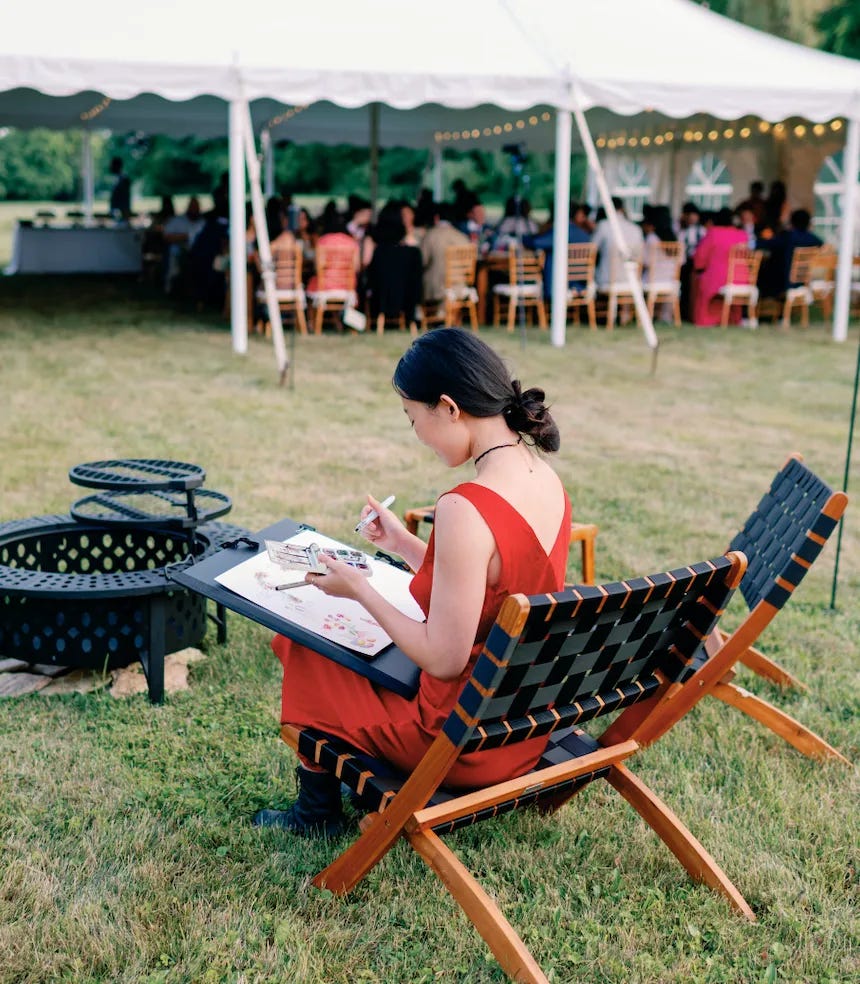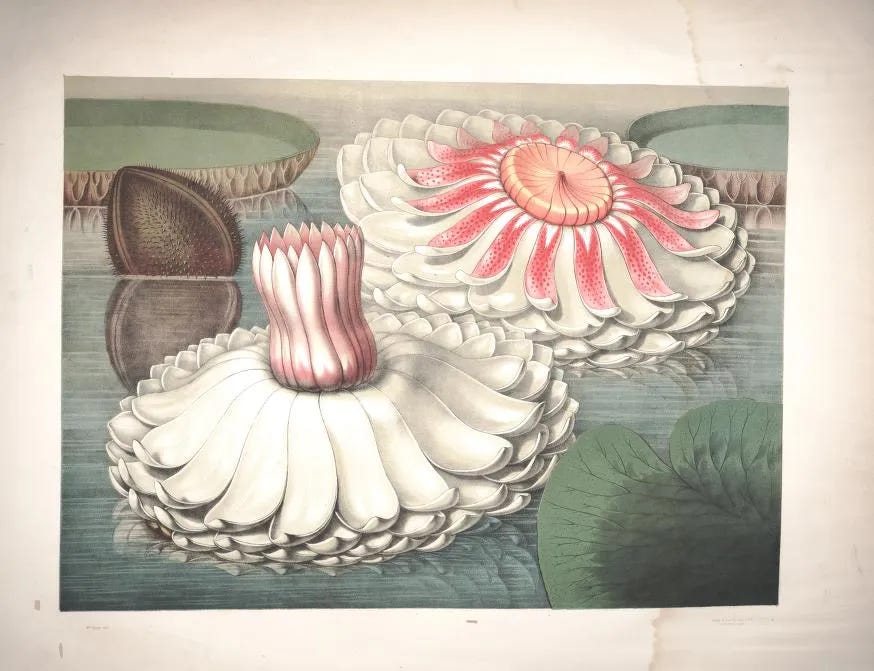“Some people flirt with everyone. Some people only flirt with people they find hot. Some people never flirt.”
In this edition of the Weekender: divine scents, people-watching, and the horror of the Aritzia changing room

This week, we’re people-watching, smelling incense, trying on jeans, and considering the poetics of slop.
PEOPLE-WATCHING
Human interest
Shani writes about what our internal architecture—from the quality of our attention to the rhythm of our speech—reveals about the way we approach the world.
21 observations from people watching
—
inPainting weddings for a few years now, I have spent a fair bit of time observing strangers move through a room. Seeing someone new, I always have a feeling of noticing their internal architecture. I did not realize that some people do not feel this way, at least not as intensely.
By internal architecture, what I mean is, when someone talks to me, what I notice first are the supporting beams propping up their words: the cadence and tone and desire behind them. I hear if they are bored, fascinated, wanting validation or connection. I often feel like I can hear how much they like themselves.
I hear the speed at which they metabolize information and the nature of their attention. Attention falls on the spectrum of jumping bean to steady stream. Where it falls depends on a person’s nature, and also how much they want to be in that conversation. Someone’s quality of attention is evident from the questions they ask (how much they diverge from what the speaker is saying), if their gaze is wandering elsewhere, if they are fidgeting, restless. The outlier is dissociation, when someone is noticeably vacant, their attention completely absent.
Sometimes I see their feelings towards me when we talk, but that has the largest room for error in retrospect. Maybe the person I have the hardest time seeing clearly is still myself. I can see people more clearly when I am watching them talk to others.
I watch the person with the loudest laugh. The most striking thing isn’t the volume—it’s the feverish pitch. As the night goes on, it begins to sound more like desperation. Their joy has a fraying quality; it is exhausting to carry because it comes with a desire to seem happy and make others happy at all times.
When someone is flirting: Flirting is marketing, revealing yourself at a specific angle to coax a certain response. People have different marketing strategies, but this is always true: there is energy that is snaking outward, trying to find a surface to grip on. It can feel intrusive when unwelcomed, and pleasurably intimate if welcomed. Some people flirt with everyone. Some people only flirt with people they find hot. Some people never flirt.
It is easy to tell how happy someone is to see another person enter a conversation. There is happy, and there is polite, and they look very different. Polite has a mechanical quality to it, like carrying out all the right movements to replace batteries in a remote. Happy has a boundless quality: unpredictable, even when it is at a low level. There is an openness, allowing another person to surprise and delight them. The easiest way to say this: there is no script for happy. It tumbles out of the body. Polite comes from the mind—it is restrained and calculated—measured lines and pauses. There are reinforcing loops in a polite person and a happy person. A person closed to the possibility of delight finds less of it. A person open to it finds more.
PERFUME
Sacred scents
As the Vatican prepares a conclave to elect Pope Francis’s successor, Miccaeli reflects on the history and role of incense in the Catholic Church.
Incense Perfumes on the Eve of Conclave
—
inIt’s hard to escape the cultural reach of the Catholic Church when you live in the Western world. It is, for better or worse, one of the load-bearing walls of our civilization. Its influence wafts from the church into the streets of civic life, the courts, the schools, the arts.
The concern of all religions is the soul, and Catholicism will walk any path it can, use any ammunition it can find, to reach yours. This includes art and song and verse and food and community and power and fear and love—and scent.
Religion, like perfume, is performative, and there is no religion that is better at performing faith than Catholicism. There’s a pageantry to the church of Saint Peter in which scent plays a prominent part. If you have ever walked into a church, you’ve smelled it. Even when you leave, it clings to you. The scent of God, the smoke from the thurible, the holy resin—the incense.
The Bible, amongst other notable uses, is a perfume lover’s dream. Its stories and passages are filled with powerful imagery of fragrance, the scent of bodies and empires and revelations. The Book of Exodus contains a passage where God, like an evaluator at Givaudan, gives Moses a briefing to blend the sacred incense to be burned in temples:
“Take unto yourself sweet spices, stacte, and onycha, and galbanum; these sweet spices with pure frankincense: of each shall there be a like weight: And you shall make it a perfume.”
Humanity does not agree on much. But it seems we can all agree that if there is a scent that is closest to heaven, it would be incense.
Technically any resin or material that is burned over coals or in ritual can be called incense, but our focus today is on the traditional interpretation of frankincense. Also known as olibanum, this material is a resin from the boswellia tree that grows natively in Eastern Africa and Southern Arabia. It has been associated with the spiritual for thousands of years, long before it was gifted to Mary by one of the wise men.
In the world of modern perfumery, frankincense is an ancient material that still has a modern resonance. There are houses and perfumers that obsess over incense like our ancestors did, trying to build monuments around its resinous, piney dryness. There are countless scents that use incense as a central note to give depth and mystery, to evoke the spiritual or the divine.
The power of incense is the same in perfume as it is in religion: it fills the air around you, the smoke filling every corner of a room or a chapel. It gets in your nose and lingers for hours in your hair. It is dry and sharp but also sweet somehow, mellow, as if it holds some kind of ancient wisdom or deep knowledge. There’s always a feeling of wafting upwards when you smell incense—as if your perfume, like a thurible, is a vehicle for sending your thoughts directly to whatever lives above.
COLLAGE

MUSIC
If You Could Read My Mind (Gordon Lightfoot cover)
—
inPOETRY
Merlin
—
inI have an app on my phone that listens to birds and names them for me on our early morning dog walks under cherry trees still dripping with the previous night's rain I hold the phone in the air and marvel how the birdsong registers in spite of the Port alarms and first responder sirens black-capped chickadees, robins northern flickers an hour from now it will be mostly crows and seagulls but this is the delicate hour when song threads between the high branches creating a lacework of whistles coos chirps and trill now there is a nuthatch oh and a song sparrow 970 steps and we've completed our trip around Hastings Sunrise I think I'll leave the window open today let spring have its way.
MOSAICS

SHOPPING
Changing room
Sudana Krasniqi captures the “fourth circle of hell” that is the Aritzia communal changing room.
Hell is an Aritzia fitting room
—
inAdmittedly, I am a basic bitch. There is little I won’t do for an overpriced, perfect white T-shirt or tailored trouser. My credit card hates to see a faux leather trench coat with a $490 price tag coming. Those $48 packs of cashmere socks? I’ll take three. Lazy and boring, perhaps. Wasteful and unnecessarily costly, sure. I’m just not one for trends or prints or bold colors. Earth tones with a healthy, constant rotation of black just work for me. Which is how I ended up ruining an otherwise lovely spring afternoon by walking into Dante’s fourth circle of hell—a place where body dysmorphia is always in bloom—an Aritzia fitting room.
If you are blissfully unfamiliar with Aritzia and their fuck ass fitting rooms, let me break down the communal mirrored horrors for you. The Canadian chain, which is every poor Shiv Roy’s wet dream, has a no-private-mirrors policy in their Pinterest-board-inspired fitting rooms. Instead of giving women privacy, they want us, already in fight-or-flight mode from battling five “clean girl” sales associates armed with Russian manicures and sleek buns, to parade out of the changing room into a communal mirrored area. A communal mirrored area. Just like when you were 9 and had to walk out to show mom your OshKosh B’gosh skirt in a sticky JCPenney stall. God forbid, at our ripe age, a woman can be trusted to decide on anything for herself.
The in-store Aritzia shopping experience seems to pride itself on making every purchase a group effort. A team sport. A town hall meeting where the 19-year-old elbowing you for mirror space and someone’s grandpa ogling you from the couch all get a vote equal to yours. Allowing you the space to tune into your own opinion is a luxury this retailer cannot afford. On the contrary, by forcing you into a fashion show literally no one asked for, they’re banking on muddling your judgment by ensuring you listen to theirs.
What woman could think clearly, with Jessica yanking the fitting-room curtain open every two minutes, wide-eyed and foaming at the mouth, demanding to know “how are we liking the jeans!?” while she already had the next size up on standby. We? Maybe she means well, but the aggressive sales tactics and abrasive tone don’t give me the impression that she did. I respect the hustle, Jess, but store engagement works best when it feels authentic and not like a monotonous cash grab.
I know I am a little older, a bit shorter, and a lot tittier than the target Aritzia customer. Still, I opted to give them and their jeans a chance. I armed myself with not one but five pairs. Surely one, please denim gods, just fucking one, had to fit.
I wrangled my way through the sea of various washed blues. Took the degrading walk of shame to the communal mirror. Patiently waited for the gaggle of girls ahead of me to disperse so I could have a moment to myself. But the damage had been done. I could no longer hear my own voice over everyone else’s. The fitting-room attendant told me it all looked “soooo good!” while my sister texted back that it absolutely did not. Thirty miserable minutes later, everything started to look the same. Everything started to make me feel less like myself. Everything started to make me feel ugly.
Of course, I left the store defeated. Unworthy of a new pair of jeans. Like a woman still incapable of making a choice on my own. Like I’d let the grown-up, healed version of myself down. The part of myself that swore she’d never go on a fat-free cottage-cheese diet ever again. Worse yet, a part of me felt like I had let Jessica, that lying bitch, down too.
Will I shop at Aritzia again? Absolutely. Online. Where I can try on overpriced basic layering pieces and oversized blazers in the privacy of my home. And forget to return the items that don’t fit. Like an adult.
PHOTOGRAPHY

LITERATURE
A theory of things
Reading William Carlos Williams on a Florida beach, Meghna Rao examines her lifelong relationship with “slop”—the stream of disposable objects Americans consume—and considers the poet’s conviction that profound meaning lies in the concrete reality of things.
Learning to love the slop
—
inI grew up, like a lot of Americans, around slop. There were these super-trendy Chinese slippers I’d bought in six different colors from Jamaica Avenue, and the mesh that covered the top third of my feet would deform into hard plastic if they were left out in the sun for too long. A pair of lime dangly earrings that hung over my shoulders once started to drip a trail of beads behind me after a single wear. The first time I went clubbing, my friend and I took a trip to the fabled Mystique Boutique in Soho and bought dresses that looked good when we first put them on, but by the end of the night were somehow stretched baggy and unflattering. The beautiful and long-lasting was reserved for objects from India, hand-woven saris, intricate gold jewelry that had been passed down, carefully, between generations. But in the U.S.? We were consumers of slop. Objects that came out of nowhere.
And even though I’ve grown up to love good fabric and cuts, there is some part of me, deep down and childish, that sometimes falls back into this tendency, to think of objects as a long, easily replaceable stream of things that do their job for a little bit before they retire. Anything beautiful is in nature and in the mind. Objects are landfill.
Two weeks ago, I went to Tampa, because my parents, like all true borough New Yorkers, have turned their retirement gaze southwards to the Floridian coasts of stable weather and lower taxes. I went with two friend-cousins who I really love. We’ve grown up together and their parents are like my own, and there is something really special about our friendship, because time spent together feels like it is about something much larger than just us three.
We went to Fort De Soto on a Saturday morning, a key about the size of my thumb’s nail on Google Maps. It has powdery-soft white sand and the water is so beautiful and clear, minnowing with little fish and gentle waves and bottlenose dolphins that belly flop right next to you, and so different from the Atlantic waters that slap you silly, that I almost declared myself a beach person.
Then emerged the question of the beach read. I had been reading William Carlos Williams’s Paterson, a strange, nearly incoherent, lucidly brilliant five-book set of poems, newspaper clippings, dialogues that take place in Paterson, New Jersey, all floating around the massive, powerful Passaic Falls.
Williams has the two poems that everyone knows, about the plums and icebox, and the red wheelbarrow, and I’d grown up seeing the two on the walls of Grand Central, right before you go downwards into the LIRR.
But I hadn’t read Paterson, which is very long and was met with celebratory and confused reception at the time, and was Williams’s attempt to reject how other poets, namely T.S. Eliot, relied on abstractions when describing reality. Williams’s big thing was “No ideas but in things.” Meaning that philosophy could best be found in the gleam of a red wheelbarrow, rather than in some lofty, faraway idea gleaned in a person’s mind.
For Paterson, those objects were the Passaic Falls, into which people dive and sometimes lose their lives, or make love underneath its small rocky perch. They were those things that had been long-promised to be manufactured in the town, and taken away: “cotton, cassimeres, wall papers, books, felt and straw hats, shoes, carriages, pottery, bricks, pots, pans and buttons needed in the United States.” They were the trash and dead fish and scum that float on the river, the newspaper clippings that told stories of women possessed and poor men killing their babies because they couldn’t afford to have them. A white hop-clover grips sand in its claws; and on that farm, a man breaks his wife’s cancerous jaw because she cannot work with him in the field. Fire ravages a tin roof and lifts it like a skirt. Materials are found at the base of a well. At 65 feet, red sandstone. At 1,370 feet, sandy rock under quicksand.
Paterson seems to have been quite radical at the time it was written. Romantic, lofty poems were still the norm, and Williams chose objects that were not beautiful or special—some were, like the thundering, massive falls. Others weren’t, like the film of oil that industry had left in it.
LIVE STREAM
Substackers featured in this edition
Art & Photography:
, , ,Video & Audio:
,Writing:
, , , ,Recently launched
Inspired by the writers featured in the Weekender? Creating your own Substack is just a few clicks away:
The Weekender is a weekly roundup of writing, ideas, art, audio, and video from the world of Substack. Posts are recommended by staff and readers, and curated and edited by Alex Posey out of Substack’s headquarters in San Francisco.
Got a Substack post to recommend? Tell us about it in the comments.


























Some of us don’t understand how to flirt… fun post.
for the record I have not been back in an Aritzia fitting room since